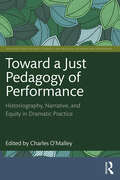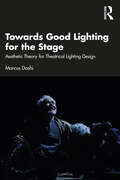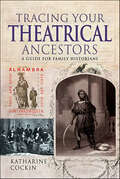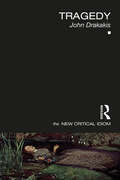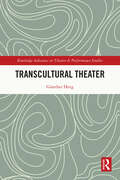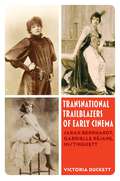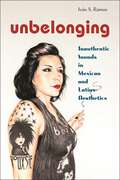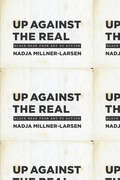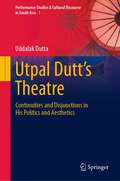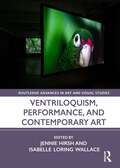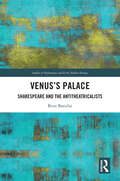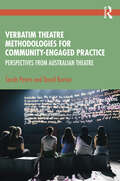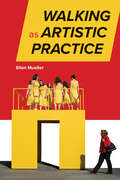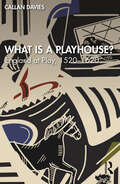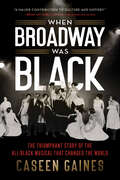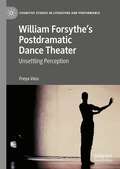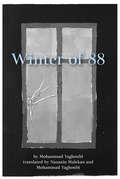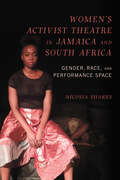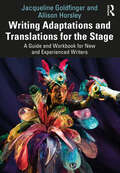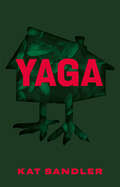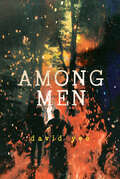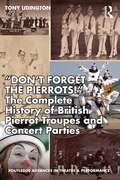- Table View
- List View
Toward A Just Pedagogy Of Performance: Historiography, Narrative, And Equity In Dramatic Practice (Routledge Series in Equity, Diversity, and Inclusion in Theatre and Performance)
by Charles O’MalleyThis book is a compendium of resources largely by and for artists and scholars interested in engaging in conversations of justice, diversity, and historiography in the fields of theatre and performance studies. For these students, and for the future instructors in our field who will use this book, we hold a tripartite hope: to expand, to enable, and to provide access. In its whole, we intend for this book to provoke its readers to question the narratives of history that they’ve received (and that they may promulgate) in their artistic and scholarly work. We aim to question methods and ethics of reading present in the western mode of studying drama and performance history. The contributions in the book—not traditional chapters, but manifestos, experiences, articles, conversations, and provocations—raise questions and illuminate gaps, and they do not speak in a unified voice or from a static position. These pieces are written by artists, graduate students, teachers, administrators, and undergraduates; these are expressions of hope and of experience, and not of dogma. This book is aimed toward instructors of undergraduates, both graduate students and faculty at all levels of seniority within theatre and performance studies, as well as at artists and practitioners of the art that wish to find more just ways of viewing history.
Towards Good Lighting for the Stage: Aesthetic Theory for Theatrical Lighting Design
by Marcus DoshiTowards Good Lighting for the Stage: Aesthetic Theory for Theatrical Lighting Design explores the theoretical underpinnings of effective lighting design from conceptualization to live performance. Through an investigation of the author’s own aesthetic point of view—grounded in a broad investigation of art and design that blends pop culture and fine art, theory, and practice—this book documents the author’s thinking on the design process to fill the unexplored gap between an aesthetic philosophy and its expression in composition. Redefinitions of the artist, artwork, and spectator link beauty and artistic efficacy to arrive at a set of principles for assessment that demand that contemporary lighting design surpass utilitarian visibility to become a vital part of the total artwork that is a theatrical production. Inspired by the movements of the broader art and design worlds of the mid-19th century through present day—citing influences as diverse as Jennifer Tipton, Lois Tyson, Dieter Rams, and Dave Hickey—this book charts a course from the artistic team’s dramaturgical work to a solo studio concept to the tech table. Engaging and wide-ranging, Towards Good Lighting for the Stage synthesizes years of cross-disciplinary research and case studies of the author’s own work into provocative reading for practitioners of lighting design, advanced students, and academics, as well as those interested in connecting theatrical practice, aesthetic theory, and visual art.
Tracing Your Theatrical Ancestors: A Guide for Family Historians
by Katharine M. CockinAn essential source of reference for researchers trying to uncover the theatrical experience of one of their forebears. How can you find out about the lives of ancestors who were involved in the world of theater: on stage and on film, in the music halls and traveling shows, in the circus and in all sorts of other forms of public performance? Katharine Cockin’s handbook provides a fascinating introduction for readers searching for information about ancestors who had clearly defined roles in the world of the theater and performance as well as those who left only a few tantalizing clues behind. The wider history of public performance is outlined, from its earliest origins in church rituals and mystery plays through periods of censorship driven by campaigns on moral and religious grounds up to the modern world of stage and screen. Case studies, which are a special feature of the book, demonstrate how the relevant records and be identified and interpreted, and they prove how much revealing information they contain. Information on relevant archives, books, museums and websites make this an essential guide for anyone who is keen to explore the subject.
Tragedy (The New Critical Idiom)
by John DrakakisTragedy is one of the oldest and most resilient forms of narrative. Considering texts from ancient Greece to the present day, this comprehensive introduction shows how tragedy has been re-imagined and redefined throughout Western cultural history. Tragedy offers a concise history of tragedy tracing its evolution through key plays, prose, poetry and philosophical dimensions. John Drakakis examines a wealth of popular plays, including works from the ancient Greeks, Shakespeare, Bertolt Brecht, Sarah Kane and Tom Stoppard. He also considers the rewriting and appropriating of ancient drama though a wide range of authors, such as Chaucer, George Eliot, Ted Hughes and Colm Tóibín. Drakakis also demystifies complex philosophical interpretations of tragedy, including those of Hegel, Kierkegaard, Nietzsche and Benjamin. This accessible resource is an invaluable guide for anyone studying tragedy in literature or theatre studies.
Transcultural Theater (Routledge Advances in Theatre & Performance Studies)
by Günther HeegTranscultural Theater outlines the idea of a transcultural theater as enabling an approximation to and an interaction with the foreign and the alien. In consideration of the allure of fundamentalist and populist movements that promote the development and practices of xenophobia worldwide, this book makes a powerful plea for the art of theater as a medium of conviviality with (the) foreign(er) that should not be underestimated. This study contributes to transcultural experience, artistic practice, and education in the medium of theater. The book’s investigation extends far into space and time and pays particular attention to the relationship between aesthetic experience, artistic practice, and academic representation. This book is for scholars and students as well as for all those working in the cultural field, especially in the field of cultural transfer.
Transnational Trailblazers of Early Cinema: Sarah Bernhardt, Gabrielle Réjane, Mistinguett (Cinema Cultures in Contact #5)
by Prof. Victoria Harriet DuckettA free ebook version of this title is available through Luminos, University of California Press’s Open Access publishing program. Visit www.luminosoa.org to learn more. At the forefront of the entertainment industries of the late nineteenth and early twentieth centuries were singular actors: Sarah Bernhardt, Gabrielle Réjane, and Mistinguett. Talented and formidable women with global ambitions, these performers forged connections with audiences across the world while pioneering the use of film and theatrics to gain international renown. Transnational Trailblazers of Early Cinema traces how these women emerged from the Parisian periphery to become world-famous stars. Building upon extensive archival research in France, England, and the United States, Victoria Duckett argues that, through intrepid business prowess and the use of early multimedia to cultivate their celebrity image, these three artists strengthened ties between countries, continents, and cultures during pivotal years of change.
Unbelonging: Inauthentic Sounds in Mexican and Latinx Aesthetics (Postmillennial Pop #28)
by Iván A. RamosHow Latinx artists engage in sonic subcultures to reject neoliberal definitions of belongingWhat is the connection between the British rock star Morrissey and the Latinx culture of transnational “unbelonging”? What is the relevance of “dyke chords” in Chicana feminist punk and lesbian dissolution? In what ways can dissonant sounds challenge systems of dominance?Unbelonging answers these questions and more through an exploration into Mexican and US-based Latinx artists’, writers’, and creators’ use of the discordant sounds of punk, metal, and rock to give voice to the aesthetic of “unbelonging,” a rejection of consumerist and nationalist mentalities. Iván A. Ramos argues that racial identity and belonging have historically required legible forms of performance. Sound has been the primary medium that amplifies and is used to assign cultural citizenship and, for Latinx individuals, legibility is essential to music perceived as traditional and authentic to their national origins. In the context of twentieth-century neoliberal policies, which cemented the concept of “citizen” within logics of consumerism and capitalism, Ramos turns to focus on Latinx artists, writers, and audiences, who produce experimental and often “inauthentic” performances and installations in sonic subcultures to reject new definitions of economic citizenship.Organized around studies of a number of artists, all whom are explored through the methodological frameworks of sound studies, performance studies, and queer theory, Unbelonging unearths how their very different genres of music share a unifying theme of dissonance. With the backdrop of neoliberalism’s attempt to define citizenship in relation to economic and cultural legibility, Unbelonging offers an urgent analysis of how these oft-overlooked queer and feminist performers and fans used sonic illegibility to challenge gender norms, official definitions of citizenship, and narratives of assimilation. Ultimately, these forms of inauthenticity move beyond negation and become ways to imagine alternative realities.
Up Against the Real: Black Mask from Art to Action
by Nadja Millner-LarsenA history of 1960s activist art group Black Mask. With Up Against the Real, Nadja Millner-Larsen offers the first comprehensive study of the group Black Mask and its acrimonious relationship to the New York art world of the 1960s. Cited as pioneers of now-common protest aesthetics, the group’s members employed incendiary modes of direct action against racism, colonialism, and the museum system. They shut down the Museum of Modern Art, fired blanks during a poetry reading, stormed the Pentagon in an antiwar protest, sprayed cow’s blood at the secretary of state, and dumped garbage into the fountain at Lincoln Center. Black Mask published a Dadaist broadside until 1968, when it changed its name to Up Against the Wall Motherfucker (after line in a poem by Amiri Baraka) and came to classify itself as “a street gang with analysis.” American activist Abbie Hoffman described the group as “the middle-class nightmare . . . an anti-media phenomenon simply because their name could not be printed.” Up Against the Real examines how and why the group ultimately rejected art in favor of what its members deemed “real” political action. Exploring this notorious example of cultural activism that rose from the ruins of the avant-garde, Millner-Larsen makes a critical intervention in our understanding of political art.
Up Against the Real: Black Mask from Art to Action
by Nadja Millner-LarsenA history of 1960s activist art group Black Mask. With Up Against the Real, Nadja Millner-Larsen offers the first comprehensive study of the group Black Mask and its acrimonious relationship to the New York art world of the 1960s. Cited as pioneers of now-common protest aesthetics, the group’s members employed incendiary modes of direct action against racism, colonialism, and the museum system. They shut down the Museum of Modern Art, fired blanks during a poetry reading, stormed the Pentagon in an antiwar protest, sprayed cow’s blood at the secretary of state, and dumped garbage into the fountain at Lincoln Center. Black Mask published a Dadaist broadside until 1968, when it changed its name to Up Against the Wall Motherfucker (after line in a poem by Amiri Baraka) and came to classify itself as “a street gang with analysis.” American activist Abbie Hoffman described the group as “the middle-class nightmare . . . an anti-media phenomenon simply because their name could not be printed.” Up Against the Real examines how and why the group ultimately rejected art in favor of what its members deemed “real” political action. Exploring this notorious example of cultural activism that rose from the ruins of the avant-garde, Millner-Larsen makes a critical intervention in our understanding of political art.
Up Against the Real: Black Mask from Art to Action (Mersion: Emergent Village Resources For Communities Of Faith Ser.)
by Nadja Millner-LarsenA history of 1960s activist art group Black Mask. With Up Against the Real, Nadja Millner-Larsen offers the first comprehensive study of the group Black Mask and its acrimonious relationship to the New York art world of the 1960s. Cited as pioneers of now-common protest aesthetics, the group’s members employed incendiary modes of direct action against racism, colonialism, and the museum system. They shut down the Museum of Modern Art, fired blanks during a poetry reading, stormed the Pentagon in an antiwar protest, sprayed cow’s blood at the secretary of state, and dumped garbage into the fountain at Lincoln Center. Black Mask published a Dadaist broadside until 1968, when it changed its name to Up Against the Wall Motherfucker (after line in a poem by Amiri Baraka) and came to classify itself as “a street gang with analysis.” American activist Abbie Hoffman described the group as “the middle-class nightmare . . . an anti-media phenomenon simply because their name could not be printed.” Up Against the Real examines how and why the group ultimately rejected art in favor of what its members deemed “real” political action. Exploring this notorious example of cultural activism that rose from the ruins of the avant-garde, Millner-Larsen makes a critical intervention in our understanding of political art.
Utpal Dutt's Theatre: Continuities and Disjunctions in His Politics and Aesthetics (Performance Studies & Cultural Discourse in South Asia #1)
by Uddalak DuttaThis book offers the reader an in-depth understanding of Utpal Dutt’s entire career in drama. Covering Dutt’s career in proscenium, street theatre and Jatra, it analyzes the interesting exchange of dramatic art with politics in his theatre. Owing to a plethora of unsubstantiated opinions, Dutt is either revered by his followers or dismissed by his opponents, but hardly ever studied with necessary objectivity and intellectual rigour. The book attempts to bust the myth that Dutt was primarily a political propagandist who used theatre only as a means to achieve his political end. The remarkable range of Dutt’s subject matter makes him as internationally significant as he is loved by Indian theatre enthusiasts. His work has been discussed on various reputed international platforms. Yet there is a stark lacuna when it comes to intellectual attention devoted to Dutt’s theatre. This is the first book which attempts to introduce Dutt’s theatre comprehensively to an international readership. The book looks briefly at Dutt’s life, the impact of his politics on his theatre, the art of his characterization, his dramaturgy and stage technique, and the legacy of his work in theatre. It also offers the reader with a chronological list of the first performances of his original theatrical works and an exhaustive bibliography, which, it is hoped, shall prove especially useful for researchers. The book is designed for lay theatre enthusiasts as well as advanced students of theatre.
Ventriloquism, Performance, and Contemporary Art (Routledge Advances in Art and Visual Studies)
by Jennie Hirsh Isabelle Loring WallaceVentriloquism, Performance, and Contemporary Art volume calls attention to the unexpected prevalence of ventriloqual motifs and strategies within contemporary art. Engaging with issues of voice, embodiment, power, and projection, the case studies assembled in this volume span a range of media from painting, sculpture, and photography to installation, performance, architecture, and video. Importantly, they both examine and enact ventriloqual practices, and do so as a means of interrogating and performatively bearing out contemporary conceptions of authorship, subjectivity, and performance. Put otherwise, the chapters in this book oscillate seamlessly between art history, theory, and criticism through both analytical and performative means. Across twelve essays on ventriloquism in contemporary art, the authors, who are curators, historians, and artists, shine light on this outdated practice, repositioning it as a conspicuous and meaningful trend within a range of artistic practices today. This book will be of interest to scholars working in art history, contemporary art, media studies, performance, museum/curatorial studies, and theater.
Venus’s Palace: Shakespeare and the Antitheatricalists (Studies in Performance and Early Modern Drama)
by Reut BarzilaiThis book lays bare the dialogue between Shakespeare and critics of the stage, and positions it as part of an ongoing cultural, ethical, and psychological debate about the effects of performance on actors and on spectators. In so doing, the book makes a substantial contribution both to the study of representations of theatre in Shakespeare’s plays and to the understanding of ethical concerns about acting and spectating—then, and now. The book opens with a comprehensive and coherent analysis of the main early modern English anxieties about theatre and its power. These are read against 20th- and 21st-century theories of acting, interviews with actors, and research into the effects of media representation on spectator behaviour, all of which demonstrate the lingering relevance of antitheatrical claims and the personal and philosophical implications of acting and spectating. The main part of the book reveals Shakespeare’s responses to major antitheatrical claims about the powerful effects of poetry, music, playacting, and playgoing. It also demonstrates the evolution of Shakespeare’s view of these claims over the course of his career: from light-hearted parody in A Midsummer Night’s Dream, through systematic contemplation in Hamlet, to acceptance and dramatization in The Tempest. This study will be of great interest to scholars and students of theatre, English literature, history, and culture.
Verbatim Theatre Methodologies for Community Engaged Practice: Perspectives from Australian Theatre
by David Burton Sarah PetersVerbatim Theatre Methodologies for Community-Engaged Practice offers a framework for developing original community-engaged productions using a range of verbatim theatre approaches. This book's methodologies offer an approach to community-engaged productions that fosters collaborative artistry, ethically nuanced practice, and social intentionality. Through research-based discussion, case study analysis, and exercises, it provides a historical context for verbatim theatre; outlines the ethics and methods for community immersion that form the foundation of community-engaged best practice; explores the value of interviews and how to go about them; provides clear pathways for translating gathered data into an artistic product; and offers rehearsal room strategies for playwrights, producers, directors, and actors in managing the specific context of the verbatim theatre form. Based on diverse, real-world practice that spans regional, metropolitan, large-scale, micro, independent, commercial, and curriculum-based work, this is a practical and accessible guide for undergraduates, artists, and researchers alike.
Walking as Artistic Practice
by Ellen MuellerWalking as Artistic Practice lays out foundational information about the history of walking and its development as an artistic practice, making it accessible to readers of all backgrounds. It also provides guidance on how to analyze and discuss walking artworks, with vocabulary support, over three hundred examples, and over seventy-five exercises. The chapters offer a variety of topical approaches, allowing readers and instructors to craft an experience most suited to their interests and needs. Themes include observational and sensory experience, leading versus following, who walks where (identity and positionality), rituals, place, activism, connections to drawing, and embodiment. Appendices include information on documentation, sample syllabi, readings and resources, brainstorming tips, community engagement guidance, and tips for travel-based study. Instructors will appreciate this text because it has so many resources to direct students to when they have questions about analysis, history, community engagement, or documentation approaches. It's the type of book that students will hang onto long after the course is done because it is so practical and useful.
What is a Playhouse?: England at Play, 1520–1620
by Callan DaviesThis book offers an accessible introduction to England’s sixteenth- and early seventeenth-century playing industry and a fresh account of the architecture, multiple uses, communities, crowds, and proprietors of playhouses. It builds on recent scholarship and new documentary and archaeological discoveries to answer the questions: what did playhouses do, what did they look like, and how did they function? The book will accordingly introduce readers to a rich and exciting spectrum of "play" and playhouses, not only in London but also around England. The detailed but wide-ranging case studies examined here go beyond staged drama to explore early modern sport, gambling, music, drinking, and animal baiting; they recover the crucial influence of female playhouse owners and managers; and they recognise rich provincial performance cultures as well as the burgeoning of London’s theatre industry. This book will have wide appeal with readers across Shakespeare, early modern performance studies, theatre history, and social history.
When Broadway Was Black: The Triumphant Story of the All-Black Musical that Changed the World
by Caseen GainesThe triumphant story of how an all-Black Broadway cast and crew changed musical theatre—and the world—forever."This musical introduced Black excellence to the Great White Way. Broadway was forever changed and we, who stand on the shoulders of our brilliant ancestors, are charged with the very often elusive task of carrying that torch into our present."—Billy Porter, Tony, Grammy, and Emmy Award-winning actor"The 1920s were the years of Manhattan's Black Renaissance. It began with Shuffle Along." —Langston HughesIf Hamilton, Rent, or West Side Story captured your heart, you'll love this in-depth look into the rise of the 1921 Broadway hit, Shuffle Along, the first all-Black musical to succeed on Broadway. No one was sure if America was ready for a show featuring nuanced, thoughtful portrayals of Black characters—and the potential fallout was terrifying. But from the first jazzy, syncopated beats of composers Noble Sissle and Eubie Blake, New York audiences fell head over heels.When Broadway Was Black is the story of how Sissle and Blake, along with comedians Flournoy Miller and Aubrey Lyles, overcame poverty, racism, and violence to harness the energy of the Harlem Renaissance and produce a runaway Broadway hit that launched the careers of many of the twentieth century's most beloved Black performers. Born in the shadow of slavery and establishing their careers at a time of increasing demands for racial justice and representation for people of color, they broke down innumerable barriers between Black and white communities at a crucial point in our history.Author and pop culture expert Caseen Gaines leads readers through the glitz and glamour of New York City during the Roaring Twenties to reveal the revolutionary impact one show had on generations of Americans, and how its legacy continues to resonate today.Praise for When Broadway Was Black:"A major contribution to culture."—Brian Jay Jones, New York Times bestselling author of Jim Henson: The Biography"With meticulous research and smooth storytelling, Caseen Gaines significantly deepens our understanding of one of the key cultural events that launched the Harlem Renaissance."—A Lelia Bundles, New York Times bestselling author of On Her Own Ground: The Life and Times of Madam C.J. Walker"Absorbing..."—The Wall Street JournalPreviously published as Footnotes: The Black Artists Who Rewrote the Rules of the Great White Way
William Forsythe’s Postdramatic Dance Theater: Unsettling Perception (Cognitive Studies in Literature and Performance)
by Freya VassThis book takes choreographer William Forsythe’s choreographic and scenographic processes as a holistic lens through which to view dance as a fundamentally visuo-sonic art form and choreography as a form of perceptual experimentation. In doing so, it reveals how the made worlds within which postdramatic dance is situated influence how choreography is perceived. Resonating with ecological perspectives but also drawing on an extensive range of cognitive research approaches, the volume’s choreo-scenographic perspective emphasizes the importance of considering the expanded scenography of lighting, sound, space, scenic elements, costume, and performer movement when analyzing the sensory and cognitive perception of dance. The volume provides a first book-length cognitive study of both an individual choreographer and the aesthetics of postdramatic theatre. It also satisfies a need for more dedicated scholarship on Forsythe, whose extensive and varied array of groundbreaking ballets and dance theater works for the Ballett Frankfurt (1984-2004), The Forsythe Company (2005-15), and as an independent choreographer have made him a key figure in 20th/21st century dance.
Winter of 88
by Mohammad YaghoubiThe events of this play are based on the author’s real experiences during the Iran–Iraq War.The play premiered in Farsi in 1997 in Tehran.The book will be published in both English and Farsi.First produced in English at the Next Stage Theatre Festival, Toronto, in January 2020
Women's Activist Theatre in Jamaica and South Africa: Gender, Race, and Performance Space (NWSA / UIP First Book Prize)
by Nicosia M. ShakesTheater is an essential theoretical and practical site for forging Black radical thought, Africana feminisms, and womanism. Nicosia M. Shakes draws on ethnographic research in Jamaica and South Africa to analyze the vital relationship between activism and theater production. Concentrating on four performance events, Shakes situates the work of theater groups and projects within a trajectory of women-led social justice movements established in Jamaica, South Africa, and globally from the early 2000s to the present. Her analysis reveals movements driven by Black women’s artistic, intellectual, and organizational labor and focused on issues that range from sexual violence to reproductive justice to the spatial manifestations of racial, gender, and economic oppression. Shakes shows how theater’s political and pedagogical roles become entangled with histories and geographies of oppression and resistance; the identities and connections created by movements of people in the context of colonial and settler colonial histories; and ideas of womanism and feminism.
Writing Adaptations and Translations for the Stage: A Guide and Workbook for New and Experienced Writers
by Jacqueline Goldfinger Allison HorsleyWriting Adaptations and Translations for the Stage is a practical guide for writing adapted works for theatrical performance. Broadway translator and dramaturg Allison Horsley and award-winning playwright and educator Jacqueline Goldfinger take readers step-by-step through the brainstorming, writing, revision, and performance processes for translations and adaptations. The book includes lectures, case studies, writing exercises, and advice from top theater professionals on the process of creating, pitching, and producing adaptations and translations, covering a wide range of topics such as jukebox musicals, Shakespeare adaptations, plays from novels, theater for young adults, and theater in translation and using Indigenous language. Artists who share their wisdom in this book include: Des McAnuff (Tony Award), Emily Mann (Tony Award), Dominique Morisseau (Broadway Adaptor, Tony Award nominee, MacArthur Genius Fellow), Lisa Peterson (Obie Award, Lortel Award), Sarah Ruhl (Broadway Playwright, Tony Award nominee, Pulitzer Prize finalist, MacArthur Genius Fellow), and Tina Satter (Broadway Director, Obie Award, Guggenheim Fellowship). The book also features interviews with artists working both in the US and internationally, as well as guest columns from artists who work in less traditional adaptive forms including cabaret, burlesque, opera, community-engaged process, and commercial theater. Writing Adaptations and Translations for the Stage is an essential resource for students and instructors of Dramatic Writing, Playwriting, and Creative Writing courses and for aspiring playwrights.
Writing Adaptations and Translations for the Stage: A Guide and Workbook for New and Experienced Writers
by Jacqueline Goldfinger Allison HorsleyWriting Adaptations and Translations for the Stage is a practical guide for writing adapted works for theatrical performance.Broadway translator and dramaturg Allison Horsley and award-winning playwright and educator Jacqueline Goldfinger take readers step-by-step through the brainstorming, writing, revision, and performance processes for translations and adaptations. The book includes lectures, case studies, writing exercises, and advice from top theater professionals on the process of creating, pitching, and producing adaptations and translations, covering a wide range of topics such as jukebox musicals, Shakespeare adaptations, plays from novels, theater for young adults, and theater in translation and using Indigenous language. Artists who share their wisdom in this book include: Des McAnuff (Tony Award), Emily Mann (Tony Award), Dominique Morisseau (Broadway Adaptor, Tony Award nominee, MacArthur Genius Fellow), Lisa Peterson (Obie Award, Lortel Award), Sarah Ruhl (Broadway Playwright, Tony Award nominee, Pulitzer Prize finalist, MacArthur Genius Fellow), and Tina Satter (Broadway Director, Obie Award, Guggenheim Fellowship). The book also features interviews with artists working both in the US and internationally, as well as guest columns from artists who work in less traditional adaptive forms including cabaret, burlesque, opera, community-engaged process, and commercial theater.Writing Adaptations and Translations for the Stage is an essential resource for students and instructors of Dramatic Writing, Playwriting, and Creative Writing courses and for aspiring playwrights.
Yaga
by Kat SandlerYaga is a mash-up of police procedural, noir thriller, comedy, and lore.Kat wanted to point out how society speaks of and labels women, especially older women.
among men
by David YeeDavid was inspired to write this after reading Al Purdy’s poem “House Guest,” the only poem that really records this period of Al Purdy and Milton Acorn’s lives.First produced by Factory Theatre, Toronto, in April 2022
“Don’t Forget The Pierrots!'' The Complete History of British Pierrot Troupes & Concert Parties (Routledge Advances in Theatre & Performance Studies)
by Tony LidingtonThis volume is the first authoritative historical textbook to look at the origins, development and evolution of seaside pierrot troupes and concert parties and their popular performance heritage. It will provide, for the first time, a definition of the pierrot troupe and its evolution from the roots of European popular traditions such as the commedia dell’arte and minstrelsy, to links between music hall and contemporary popular culture. Tony Lidington will explore how pierrot troupes grew from a single idea into a major international cultural industry and how it boosted morale and national identity during the two World Wars, before sublimating into contemporary pop music and comedy. Tony’s continuing practice as research provides an experiential framework for the historical and ethnographic analysis of the form. This book will be of vital interest to students, researchers, and performers of outdoor (al fresco) arts, clowning and comedy, minstrelsy, vernacular music-making and music hall.
